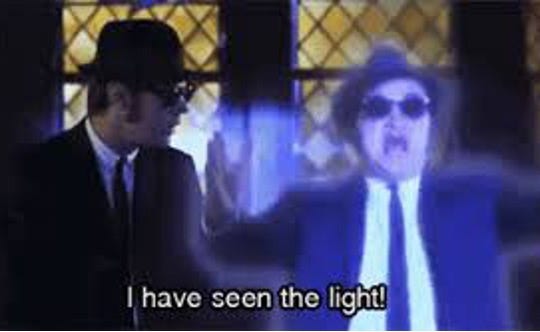Curtis: “Well, the sister was right. You boys could use a little churching up. Slide on down to the Triple Rock and catch Reverend Cleophis. You boys listen to what he’s got to say.”
Jake: “Curtis, I don’t wanna listen to no jive ass preacher talking to me about heaven and hell.”
Curtis: “Jake, you get wise! You get to church!”
At the Triple Rock Church …
Reverend James: “… too late yeah, too late for them ever to see again, the light they once chose not to follow, don’t be lost when the time comes. … Amen. Amen.”
Reverend James:“Do you see the light?Have you seen the light?”
A regular pattern of sunlight and darkness has been the consistent environmental stimulus driving our biology, from the simplest life forms to modern man. This regular pattern is called the circadian rhythm or circadian cycle. The cells in our body function in two distinct modes: activity-feeding during sunlight and resting-starvation during darkness. Each mode has its own genetic expression, metabolism and hormonal activity. Our circadian rhythms are regulated by a circadian clock that rhythmically co-ordinates biological processes so they occur at the correct time to maximize the health benefits to the body. Blume, C., C. Garbazza & M. Spitschan, “Effects of light on human circadian rhythms, sleep and mood,” Somnologie (Berl) 23(3):147-156 (Sep 2019). https://doi.org/10.1007/s11818-019-00215-x
Light exposure dictates the mode we are in. Sun entering our eyes is the body’s “on” switch. When light hits the photoreceptors in our eyes, our brain’s suprachiasmatic nucleus (SCN) turns on the body’s cells for proper functions in the morning and throughout the day. The SCN is a group of nerve cells located deep in your brain in your hypothalamus. Less light at night tells the SCN to change the cellular functions to rest and repair, in other words to sleep. LeGates, T., D. Fernandez, & S. Hattar, “Light as a central modulator of circadian rhythms, sleep and affect,” Nat Rev Neurosci 15(7):443-54 (Jul 2014). https://doi.org/10.1038/nrn3743; Mead, M., “Benefits of sunlight: a bright spot for human health,” Environ Health Perspect 116(4):A160-7 (Apr 2008). https://doi.org/ 10.1289/ehp.116-a160 Erratum in: Environ Health Perspect 116(5):A197(May 2008).
While we have long been admonished to protect ourselves from sun exposure, it has also been long established that sunlight has health benefits, and it turns out the quantity and quality of light makes a difference. The intensity of light outside on a clear day is thousands of times the amount with artificial light. Even in shade the intensity is over hundreds of times greater than with artificial light. Weller, R., “Sunlight: Time for a Rethink?” J Investigative Derma144(8):1724-1732 (2024). https://doi.org/10.1016/j.jid.2023.12.027
Luminous flux (measured in lumens) is a measure of the total amount of visible light that is present at a particular point, and illuminance (measured in lux) is a measure of the intensity of that light at that point. 1 lux = 1 lumen per square meter. Make this science relevant to me. Direct sunlight is 32,000 to 100,000 lux, full daylight without direct sun is 10,000 to 25,000 lux, an overcast day 1,000 lux. A family living room can range from 50 to 80 lux. Typical office lighting is 320 to 500 lux. Contrast daylight with nighttime. Full moon on a clear night is 0.05 to 0.3 lux; a moonless clear night 0.002 lux; and a moonless, overcast night sky 0.0001 lux. Simply speaking, the more sunlight early in the morning, the better. The more darkness at night, the better.
Ok, sunlight triggers my suprachiasmatic nucleus (SCN), which you say is clearly important. Can’t I just look out through the window; do I have to go outside (it’s winter …). Besides the metabolism, hormone and genetic expression triggering, sunlight triggers vitamin D production in our body. Vitamin D has many health benefits such as sharper eyesight, better memory, strengthening bones and teeth, supporting immunity, and slower aging. The Cleveland Clinic reports that vitamin D deficiency is a global problem. Ultraviolet B radiation (UVB) is the type of radiation that triggers vitamin D production in the body and turns it into the active form of vitamin D. The desirable UVB is almost completely blocked by ordinary window glass. Unfortunately, window glass does not block UVA, which is what causes skin damage. UVA does not trigger vitamin D and exposes your skin to damage; not a good idea. Wacker, M., & M. Holick, “Sunlight and Vitamin D: A global perspective for health,” Dermatoendocrinol 5(1):51-108 (Jan 1, 2013). https://doi.org/10.4161/derm.24494; Jaworeck, S., & P. Kriwy, “It's Sunny, Be Healthy? An International Comparison of the Influence of Sun Exposure and Latitude Lines on Self-Rated Health,” Int J Environ Res Public Health 18(8):4101 (Apr 13, 2021). https://doi.org/10.3390/ijerph18084101
Try this experiment. When you awaken and soon after sunrise, open the door or go outside and look around. Watch the golden sunrise for a few minutes. And do so even if it’s cloudy, or rainy, or snowy. You know where the sun rises; look that direction. It does not have to be direct sunlight; it just has to be fresh sunlight that morning (love those photons!). See if your day starts better, more energy, more engagement. How do you feel? Sometimes it’s the small, seemingly inconsequential that makes a difference.
That takes care of the start of the day. What about its end?
As explained earlier, as sunlight fades at the end of the day, it tells our body it’s time to switch off and go into rest and relaxation mode. We experience hormonal and metabolism changes. We also experience a mood change. The playing of Taps is our message:
The availability of artificial light in the first decade of the 1800s heralded fundamental changes in our lifestyle. Arrival of television in 1938 followed and computers in 1971 led to equally dramatic changes in lifestyle. Artificial light is a biologically disruptive technology. It desynchronizes us from our chronobiology, the circadian rhythm encoded in our genes. Contrary to the beliefs of some, we cannot yet (and perhaps never) overcome our evolution.
What happens to our bodies when we are bathed in artificial light at night? The first effect is a delay in preparing for sleep, specifically the release of melatonin. Melatonin is a hormone produced by the pineal gland located in the middle of your brain. The pineal gland is controlled by the suprachiasmatic nucleus (SCN). During the day sunlight striking the retina of your eye sends signals to your SCN that tells your pineal gland to stop producing melatonin. This helps keep you awake. At night, or more appropriately, onset darkness tells the SCN to tell the pineal gland to make melatonin. As melatonin levels increase both your body temperature and blood pressure drop and you start to feel calm and sleepy. Simultaneously, melatonin loops back to the SCN to tell it to slow down neural firing to prepare your body for sleep. Gooley, J., et al., “Exposure to room light before bedtime suppresses melatonin onset and shortens melatonin duration in humans,” J Clin Endocrinol Metab 96(3):E463-72 (Mar 2011). https://doi.org/10.1210/jc.2010-2098; Nelson R. & S. Chbeir, “Dark matters: effects of light at night on metabolism,” Proc Nutr Soc 77(3):223-229 (Aug 2018). https://doi.org/10.1017/S0029665118000198
Darkness also promotes the body’s natural repair processes. During deep sleep, the body engages in cell repair and DNA restoration, aided by the protective effects of melatonin. Walker, W., et al., “Circadian rhythm disruption and mental health,” Transl Psychiatry 10(1):28 (Jan 23, 2020). https://doi.org/10.1038/s41398-020-0694-0
What interferes with this process? Light exposure at night, eating the wrong foods too late, and an erratic sleep pattern lead to mitochondrial dysfunction, oxidative stress, and chronic inflammation, all of which encourage gut dysfunction. Mitochondria control the amount of energy that goes into our cells that allows them to function. Oxidative stress is a functional imbalance in the workings of our cells that can lead to cell and tissue damage. Inflammation is the body’s response to injury or infection. Wow, what a bunch of big words, all of which do not sound good (and they are not)! Even worse, they combine to make us gain weight.
As you go through your day, gradually reduce your exposure to artificial light, especially blue light from screens. Use blue light filters, dim lights in the evening, some advocate using red bulbs, especially closer to bedtime. Albreiki, M., B. Middleton & S.Hampton, “A single night light exposure acutely alters hormonal and metabolic responses in healthy participants,” Endocr Connect 6(2):100-110 (Feb 2017). https://doi.org/10.1530/EC-16-0097; Bedrosian, T. & R. Nelson, “Timing of light exposure affects mood and brain circuits,” Transl Psychiatry 7(1):e1017 (Jan 31, 2017). https://doi.org/10.1038/tp.2016.262; Ishihara, A., A. Courville, K. Chen, “The Complex Effects of Light on Metabolism in Humans,” Nutrients 15(6):1391 (Mar 14, 2023). https://doi.org/10.3390/nu15061391
What not to eat into the night; the list is long and attractive. Alcohol suppresses REM (rapid eye movement) sleep that is necessary for cognitive and emotional health. Coffee and tea have caffeine, even decaf has some. One exception is chamomile tea. Chocolate and candy; chocolate because of the caffeine, candy because of the blood sugar spike from the sugar. Pasta and pasta because of the carbohydrate loading plus for the pizza the cheese, oil and tomato sauce. Citrus fruits because of the citric acid effects on your stomach. Spicy foods raise your body temperature when you want it lowered to facilitate sleep. Finally, cereals with a lot of refined sugar. You can tell if you have eaten something that is going to interfere with sleep; listen to your body.
Not snacking after dinner is best. If you need a snack, go for fruits like bananas, kiwi, tart cherries, and strawberries. Yogurt and crackers with cheese, especially soft cheeses like brie, also work, but not too much. Your body needs time to digest carbohydrates and fats before going to sleep. Leave the protein for earlier in the day.
Erratic sleep compounds problems, especially food related ones. Erratic sleep encourages release of the hunger hormone ghrelin and reduces the fullness hormone leptin, both of which drive a desire for calorie-dense, high-carbohydrate foods. Klok, M, S. Jakobsdottir, M. Drent, “The role of leptin and ghrelin in the regulation of food intake and body weight in humans: a review,” Obes Rev 8(1):21-34 (Jan 2007). https://doi.org/10.1111/j.1467-789X.2006.00270.x; Ibrahim Abdalla M., “Ghrelin - Physiological Functions and Regulation,” Eur Endocrinol 11(2):90-95 (2015 Aug 2015). https://doi.org/10.17925/EE.2015.11.02.90; Ramos-Lobo A. & J. Donato, “The role of leptin in health and disease,” Temperature (Austin) 4(3):258-291 (2017 May 26, 2017). https://doi.org/10.1080/23328940.2017.1327003
Mother Nature built into each of us dynamic systems for health and wellness. Modern life has interfered and sometimes overwhelmed these natural systems, often to our detriment. It doesn’t take much to correct or start to correct the body’s mechanisms for better health, wellness and the fullness of life. Get that early morning blast of unobstructed sunlight. Turn those lights down in the evening, and put away your screen electronics early. Sit in front of the fireplace and talk or read a book (a paper book, not an electronic reader!). Be well, stay well.









Great insights as always!
I enjoyed this. ❤️